Guessing at your pricing is a little like throwing darts blindfolded. You’ll hit something—but it probably won’t be the dartboard. And setting prices based on cost or what your competition’s charging might get you closer—some darts might even land on the board.
For most companies, though, there’s still plenty of room for improvement. That’s where pricing optimization comes in. Optimizing your pricing to balance value with profit can have a huge effect on your company’s success—once you find the right price, everything becomes easier, from sales and marketing to growth and profitability.
You can’t afford to overlook optimizing your pricing. And I won’t lie—understanding what each of your customers is willing and able to pay does take some effort and research. But pricing optimization tools like Price Intelligently make the process much faster and easier than ever before.
Let’s delve into a few of the common mistakes companies make when it comes to price optimization, what you should be optimizing for, and how you can get started optimizing your pricing.
What is price optimization?
Price optimization is the practice of analyzing customer and market data to find the most optimal price point for a product or service. The goal of price optimization is to determine the best price that will help attract customers, maximize sales, and increase profits.
Information used in price optimization includes things like:
- Customer survey data
- Demographic and psychographic data
- Historic sales data
- Operating costs
- Inventories
- Machine learning outputs
- Subscription lifetime value and churn data (for subscription business models)
Pricing optimization is a similar process to dynamic pricing strategies used in hospitality, travel, ecommerce, and other industries, although dynamic pricing tends to change much more rapidly as companies tweak pricing to match real-time demand.
Three things you need to optimize for
The goal of price optimization is to find that perfect balance of profit, value, and desire. Since you can’t control which products and features customers want, and adding valuable product features takes time and effort, most companies start finding that balance by setting two things: the starting price of their product or services, and any discounts or promotions they might offer.
1. Starting prices
Your starting price, or base price, is important since it lets customers know whether your product or service is worth their time and investment. Starting prices should be optimized to match the baseline demand for your product before any discounts or promotions are applied. Optimizing the starting price works well for companies with products and services that remain fairly stable over time, like groceries, office supplies, or even SaaS products.
2. Discounted prices
If you’re in sales, you need to know what works best to pull in new customers. Offering your product at a discount—or, in some cases, even offering a freemium version—is a great way to bring in new customers (customers acquired through freemium offerings cost nearly half as much to acquire as those who sign up for paid offerings directly).
3. Promotional prices
What promotional offers would serve you and your customers best? Will markdowns create any additional profit, or are you better off charging the starting price? How big of a discount should you offer below your starting prices? How long will something take to sell at a specific price point? Optimizing your promotional prices can help boost sales for newly introduced products and promotional bundles—for example, a SaaS company launching a new product, or bundling multiple products.
Why many companies fail at price optimization
To make a long story short, most companies aren’t willing to put in the effort to optimize their pricing decisions. All the customer research needed to figure out the right valuations takes time and effort. Surprisingly, the average company only spends less than ten hours per year on their pricing strategy, which is not enough.
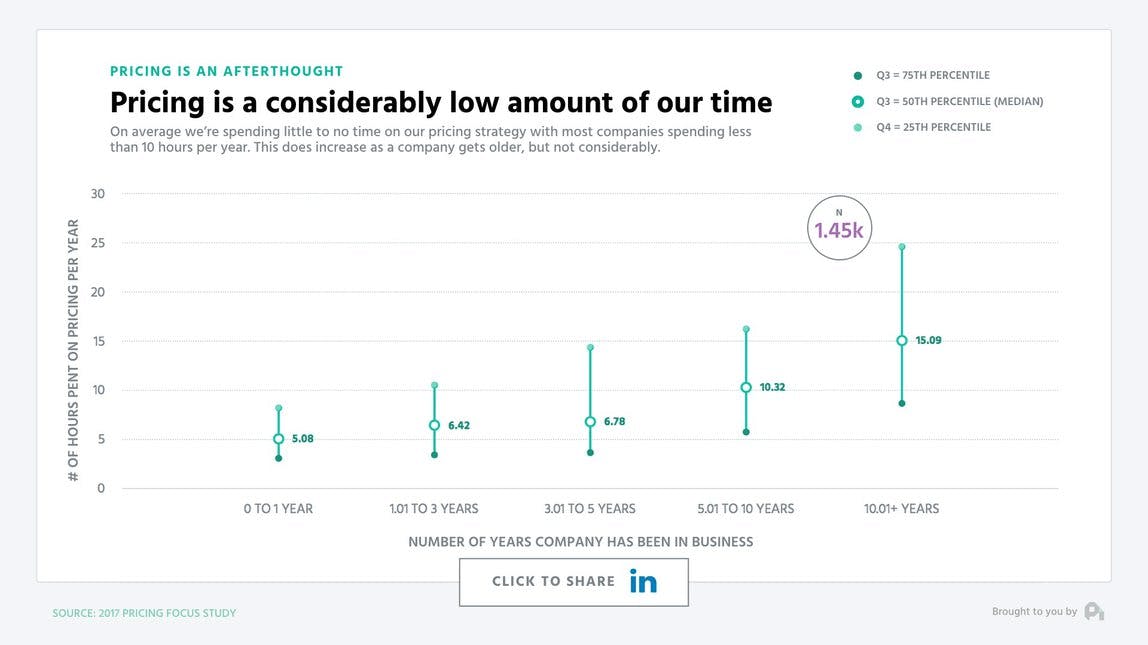
Instead of coming up with a bullet-proof price optimization strategy, companies turn to strategies like guessing, relying on discounts, and not pricing based on value.
Guessing
Many companies simply guess what an optimal price point would be instead of using analytics and metrics that their customers have given them. It’s an insidious cycle. With the right positioning and promotion, even guessing at your prices will work to some extent—it’s easy to take that as a sign that your pricing is “good enough.” Ultimately, though, without the right price optimization strategy in place, you are leaving money on the table.
Misunderstanding tiers
Many companies don’t know how many different pricing tiers or levels they should incorporate into their pricing structure. It’s a common misconception that more tiers equals more conversions. Data shows that too many or too few options pushes away potential customers, with a clear decrease in conversion rates as the number of tiers gets higher.
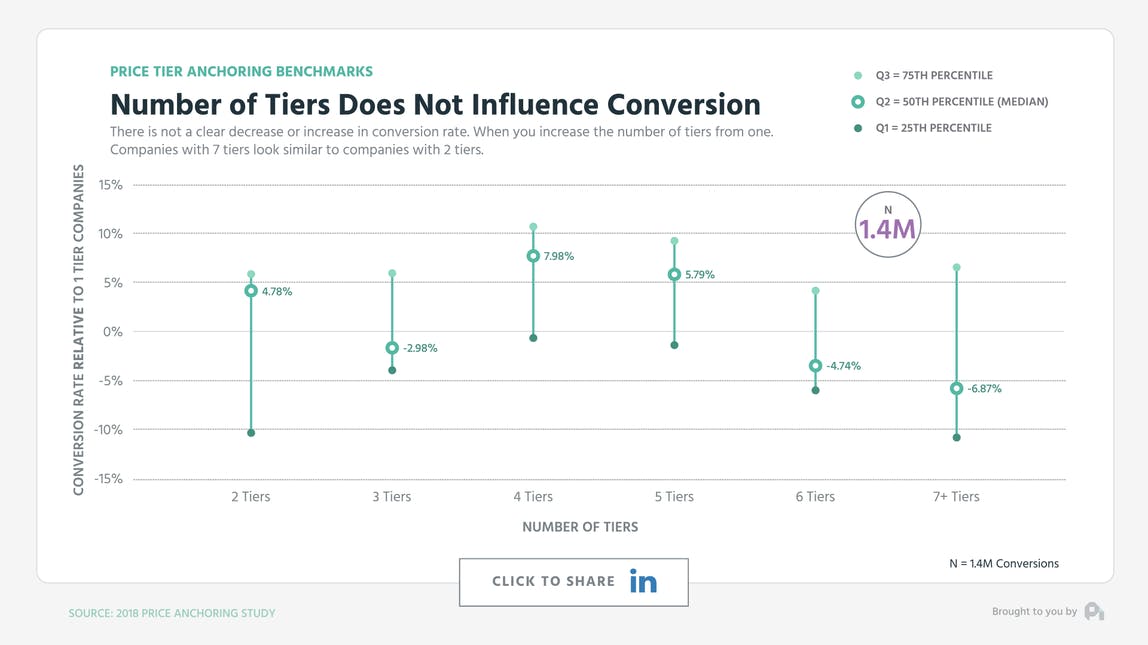
Relying heavily on discounts
The problem with discounting is that many companies wield discounting like a sledgehammer instead of a scalpel. Yes, it juices your acquisition metrics in the short term, but over time discounting can reduce your SaaS lifetime value by over 30%. Discounted customers have just over double the churn rate of those who pay full price—they’ve either been trained to devalue the product, or they just weren’t the right customers in the first place.
Not pricing for value
Value-based pricing is the best price optimization model since it includes both you and your customer’s optimal prices. The goal with value-based pricing is to figure out how much each customer is willing to pay for your product, so you can maximize revenue by charging each customer exactly what they’re willing to pay. Figuring out what that price should be, though, isn’t easy.
Not localizing pricing
When expanding into new territories or growing on a global scale, localizing your pricing gives you a leg up. But it’s something that all too many company owners overlook because proper localization requires time and research - which gets in the way of getting your business out there quickly.
That’s why so many companies lose out on revenue by setting their prices based on those of their competitors or on their costs—they don’t want to put in the effort.
How to optimize your pricing
Deciding on the right product pricing strategy —a price that maximizes value for customers and profit for you—starts with gaining a deep understanding of your customers. Price optimization is all about understanding who your best customers are, what features they like, and what features they need. You also need to understand your market: retailers will have different considerations than B2B companies. Once you understand that, you can align your pricing with what they value, tracking the results of the price changes you make and improving over time.
1. Get to know your customers
Optimizing your pricing is all about the data—both qualitative and quantitative. Hard data is the only way to find out how much customers are willing to pay for your product, and it’s the key to breaking free from the guessing cycle.
Quantitative data, like transactional data, customer reviews, supply and demand data, churn rate, MRR, and more show you how you’re doing and what needs to be changed. Software like Price Intelligently can help you make sense of those metrics and turn them into pricing insights by slicing and dicing your data based on demographic, psychographic, and customer preferences.
Just as helpful, qualitative data comes from talking to customers. Surveys are great, but they’re no match for picking up the phone and actually talking to customers, asking them about topics such as their price sensitivity and what features or benefits they value most in your product.
2. Quantify value
Once you’ve collected all your customer data, it’s time to work out what “value” actually means to your customers. That means working out your value metric. Your value metric is essentially what and how you’re charging for your product—identifying and pricing along your proper value metric is the difference between surviving and thriving.
Check out this pricing page example from user analytics service Hotjar. Hotjar’s value metric is pageviews—the price increases depending on how many pageviews your site handles per day.
Other common value metrics for SaaS companies include the number of seats, the number of files hosted, bandwidth used, and more. Your value metric should align with your customers’ needs and should be easily scalable. You can read more about finding your value metric right here.
3. Analyze the data
You’ve collected some customer data and worked out what your customers value—now it’s time to look for patterns in the features, benefits, price points, and value metrics that drive or detract from value. You’ll also find out how willing different segments and personas are to pay different prices for your products.
Use your findings to create tiers and proper packages for your product or services. Each tier should be priced along your value metric, and should align with your different buyer personas so that you're offering the right amount of product or service to each customer segment.
4. Adjust pricing and monitor
Even once you’ve set your prices, you’re still not done with price optimization—the value you provide versus your competitors’ is constantly changing, so you need to be constantly monitoring and adjusting your pricing.
Pricing is an ongoing process. You should use your pricing strategy to eliminate as much doubt as possible. Think back to our dartboard example from earlier—adjusting your pricing helps eliminate sections of the dartboard, focusing in on the right region for your dart to land as you learn more about what works.
You need to continually collect data and analyze the value customers are getting from your product to make sure that what you’re offering still meets your customers’ needs and pricing desires. Make sure you keep a very close eye on your pricing, and see how customers respond. If need be, re-evaluate and change things up—but don’t be too quick to switch, since you might alienate potential or existing customers.
Example #1: Pinegrow takes Brazil (eventually)
Pinegrow, the website building software, were seeing this exact issue when selling to customers in Brazil in USD at the same price point as their home market.
When they decided to not only offer Brazilian Real (BRL) on their checkout but also lower their prices to reflect what people were actually able - and willing - to pay in Brazil, they saw a considerable amount of new customers.
This increase in customer volume outweighed the discounted price, ultimately increasing Pinegrow's revenue in that market. The BRL prices that Pinegrow used were over a third lower than their initial USD equivalent. Far from harming their bottom line, they saw their sales leap a massive 177% even with that heavy discount.
Knowing your customer and their buying power is a great way to maximize conversion, especially in emerging markets.
So, what do you have to consider when researching the territory or territories you want to expand into? Let’s have a look at the main factors:
- Currencies that people use
- Disposable income
- Local pricing of competitors
- The size of your industry in that market
- General demand for your product
If this is somewhere you think your business is losing out on revenue due to the lack of a considered approach, then I suggest you hop on over to read our full guide to pricing localization.
Example #2: Tweakbit do some tweaking
Tweakbit sells anti-virus software in a very competitive market, and because they buy the software to solve a particular need (no one likes a computer virus), they don’t necessarily have strong brand loyalty. This could put them in the ‘high’ category of sensitivity.
...Which is exactly what Tweakbit’s pricing is designed to address. With some heavy discounting, both upfront and as the customer moves through the buying journey (in the form of time-based promotions), Tweakbit encourages their customers to view their software as a real bargain. On top of that, they also run regular coupon and promotion campaigns to ensure that customers’ pricing expectations are met.
The main takeaway here is that companies need to strategically determine the right price and billing models for their specific customers, using research, market knowledge, and customer insights.
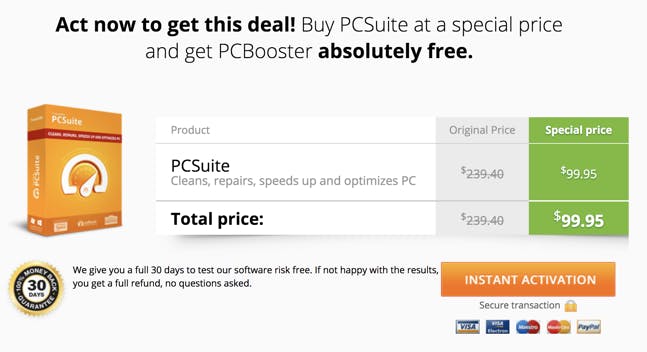
Example #3: Smile Software optimize for upgrades
Let’s talk about Smile Software, who released an upgrade to PDFPen (their PDF editing software), with a very user-focused approach.
Firstly, they sent an email to their customers to encourage them to upgrade via the PDFPen app. This was because the in-app experience could automatically validate their existing license, and handle the free upgrades automatically as well.
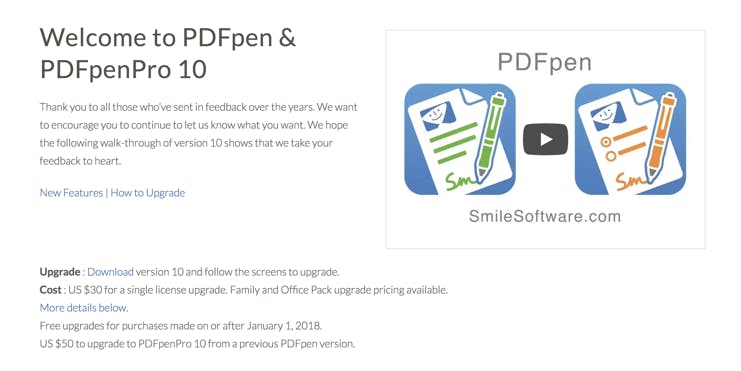
For those that bought the latest version of the product in January of that year, Smile Software offered a free upgrade. For those that had bought a version earlier than the year before, Smile Software introduced a tiered system.
This tiered system was created to evaluate how much an upgrade from pro to prop ($30) or basic to pro ($50) would cost them. This gave clarity to existing customers, letting them see the cost of upgrading from their previous tier.
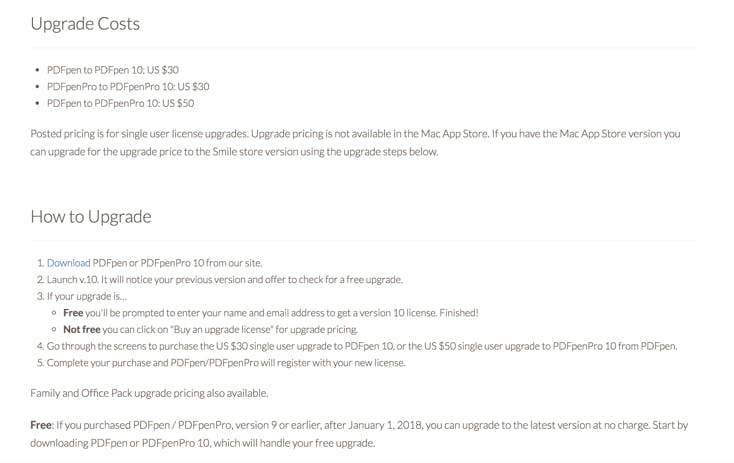
6 features to look for in pricing optimization software
Pricing optimization has come a long way from the time-consuming processes of yesteryear. These days, software like Price Intelligently can make the process of collecting customer data, optimizing your prices, and maximizing profits much easier. Price optimizations solutions can also use algorithms and artificial intelligence to automate processes involved with pricing and make your life easier. No matter which pricing optimization tool you choose, here are a few must-have features you should look out for.
1. Pricing and packaging
How exactly do you differentiate your pricing for features and plans? The right pricing optimization tool can tell you which features customers value the most, and are most willing to pay for, with clear package and pricing recommendations throughout the customer lifecycle based on the data analysis.
2. Price localization
Localizing your pricing can increase conversions by 11-18%. Optimizing your pricing through software can help you capture more of that growth, keeping customers satisfied wherever they are in the world.
3. Buyer personas
Who is buying your product and how can you target the best customer segment? Pricing optimization software can help you with customer segmentation and tell you which demographics you should be targeting, as well as which features and value propositions customers are most willing to pay for.
4. Roadmapping
Your development time is limited, so you should always be spending time wisely on features that will drive retention. Before you start building, use pricing data to drive your product roadmap by learning which potential features will appeal to the most customers and drive the highest revenue. Conduct customer retention analysis to determine customer engagement with the features once they're live.
5. Moving to a subscription model
Pricing optimization software should make moving from one-time payments to a subscription business model smooth and straightforward, letting you join the subscription economy without losing customer satisfaction (or revenue).
6. Competitive monitoring
Stay ahead of the curve and monitor your brand with minimal input using automation. Pricing solutions should tell you which features and parts of your brand are winning you customers versus your competitors, letting you monitor the amplification (or lack thereof) of your brand and ensure you're setting competitive prices.
Stop leaving money on the table
It really is a shame that so many companies don’t spend time on their pricing. Poor—or, for most companies, non-existent—price optimization can lead to lots of problems, missed opportunities, and low revenue.
It doesn’t matter what you’re selling—SaaS software, groceries, fancy purses, or even heavy machinery. Optimizing your pricing is such a high-impact growth lever, it’s something you can’t afford to miss out on. With the right tools for optimizing your pricing, the process doesn’t have to be difficult.
Price optimization FAQs
Why price optimization is important?
Smart price management and optimization can help companies attract more customers, increase sales, and maximize profits. By finding the price that best represents the balance between the product/service value and profit, you are more likely to meet your target clients' expectations and motivate them to make a purchase.
How do you build a price optimization model?
To build the most accurate price optimization model that will help boost sales and profit margin, take the following steps:
- Pull and analyze historical data
- Analyze customer behavior
- Define your business goals
- Set pricing tiers
- Regularly monitor results to adjust your pricing if necessary
What are the most common pricing strategies?
There are multiple pricing strategies to opt for when setting the price for your products or services. Some of the most commonly used ones include:



